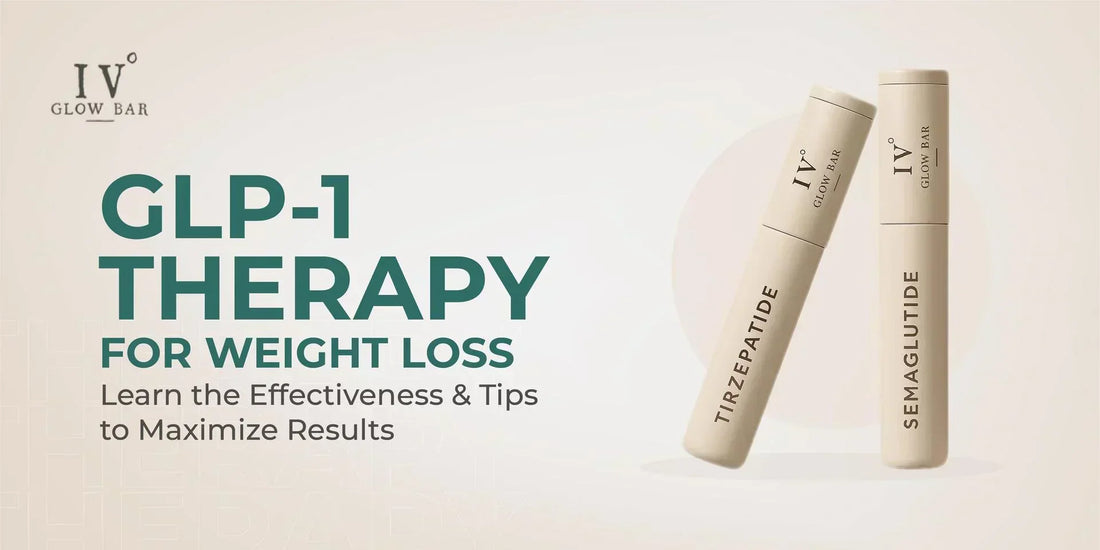GLP-1 Therapy for Weight Loss: Effectiveness, Safety, and Tips
Written & Medically Reviewed by Nurse Hannah
Share

The New England Journal of Medicine shared powerful results on semaglutide. Within a year, people on the treatment reduced nearly 15% of their body weight. For those living with obesity for so long, this change brings more than lighter numbers on a scale and a new hope.
I meet patients every week who ask me: “Do GLP-1 medications like Wegovy® or Zepbound™ really work?” I understand the hope, the hesitation, and sometimes even the frustration behind this question.
Weight loss GLP-1 therapies can bring great results, that’s true. Still, the progress doesn’t rely on the shot by itself. It comes alive when you add the right lifestyle changes, daily habits, and smart strategies that help your body reach and hold onto long-term health.
Here, I’ll explain what studies reveal, add what I’ve noticed while working with people, and share tips backed by research to help you achieve safe and effective results.
Disclaimer: As a registered nurse, I want to make this clear. What I share here is for education and support. It should never take the place of advice from your doctor. Always talk with your healthcare provider before you decide to adjust your treatment plan.
1. Start Slow & Titrate
One of the first lessons I share with patients starting GLP-1 therapy is: be patient with the process. These medications, whether semaglutide (Ozempic®, Wegovy®) or tirzepatide (Mounjaro™, Zepbound™), are designed to start at a low dose and slowly increase over weeks.
Why? To minimize gastrointestinal side effects like nausea, diarrhea, or constipation. I’ve seen patients try to “rush” to the higher doses, hoping for faster weight loss, but that often backfires, leading to discomfort or even stopping the medication altogether.
Your provider will map out a titration schedule, usually every 4 weeks. Respect that pacing. Think of it as teaching your body to adapt rather than overwhelming it. The slow ramp-up builds tolerance while still moving you toward effective doses.
2. Pair Therapy with High-Protein Meals and Resistance Training
One of the biggest concerns with weight loss, whether through medication, diet, or surgery, is losing muscle mass along with fat. Studies show that people on GLP-1s can lose up to 25–30% of their lean muscle if they don’t protect it.
That’s where protein and strength training come in.
Each meal should bring in 20–30 grams of protein. Match it with strength training, like lifting weights or using resistance bands. Even bodyweight exercises count. This combination keeps lean muscle safe. Muscle isn’t only about looking strong. It lifts your metabolism, takes care of your joints, and keeps your body ready for an active life.
Here’s something I always share with patients. GLP-1 therapy helps cut down appetite. You’ll likely eat less without even planning to. But when food goes down, nutrients do too. Keep protein a top priority; it will protect your strength now and your health years ahead.
3. Hydration & Small, Frequent Meals
During the first weeks, nausea shows up for many. Clinical guidance notes that gradual titration, hydration, and meal adjustments improve GI tolerability of GLP-1 therapy.
It can be tough, though a few small changes often bring relief and comfort. Two key strategies include:
- Stay hydrated: Aim for 60–80 ounces of water daily, sipping slowly instead of gulping.
- Eat small, frequent meals: Instead of three large meals, try 5–6 smaller ones. This reduces stomach burden and helps your body adjust to slower digestion caused by GLP-1s.
Some people notice relief from mild nausea by drinking ginger tea or sipping peppermint. The good news is these effects don’t last forever. Most improve within six to eight weeks, and a slower step-up in dose makes the process easier.
4. Track Body Composition, Not Just Scale Weight
Seeing your weight on the scale can make you smile or sigh. The number matters to some extent, but it cannot explain everything about your body.
I encourage patients to track body composition (fat vs. muscle) with tools like bioimpedance scales, DEXA scans, or even tape measurements for waist circumference.
Why does this matter? It’s not simply about watching the scale go down. The bigger win is feeling healthier. Dropping deep belly fat that surrounds your organs can lower the chances of diabetes, heart problems, and high blood pressure, even when the overall weight loss doesn’t look big.
When patients see their waist shrinking or their A1C improving, it supports that the medication is working on a deeper level than just the bathroom scale.
5. Set Staged Goals
GLP-1 trials give us useful benchmarks:
- 3 months: Many patients see 5–7% body weight reduction.
-
6 months: Often 10–12%.
- 12 months: Up to 15–20%, depending on the dose and medication.
Expecting everything to change in a few short weeks can set you up for disappointment. It’s smarter to work toward staged goals. Small victories, like hitting your first 5% drop, deserve recognition. Clinical studies show even this level of progress makes a difference. Blood pressure lowers, cholesterol improves, and blood sugar becomes easier to control.
Weight loss is a marathon, not a sprint. And GLP-1 therapy is about long-term health improvement. It is not just quick fixes.
6. Address Sleep & Stress
Stress and lack of sleep have ruined progress for many of my patients. Research links poor sleep and high cortisol to increased appetite and reduced weight-loss success, even in GLP-1 therapy. Prioritizing 7–9 hours of rest and stress management tools like mindfulness, yoga, walking outdoors, or simply setting better work-life boundaries can improve outcomes.
GLP-1 treatment gives support, but high cortisol caused by stress or poor sleep habits often leads to cravings. These hormone imbalances result in a slower weight loss journey.
Remember: these medications regulate appetite, but lifestyle still sets the stage. Think of sleep and stress care as invisible allies in your journey.
7. Medication Adherence
Getting the best outcomes from GLP-1 treatment comes down to keeping up with the prescribed routine. Staying on track with the dose exactly as directed matters a lot. Real-world data shows that patients using weekly GLP-1 shots tend to stay more regular and dedicated compared to those relying on daily dosing.
Here are the key points:
Taking your dose on the same day each week matters. Weekly dosing regimens (like certain forms of semaglutide or dulaglutide) have been associated with better adherence (e.g., higher proportion of days covered ≥80%) compared to daily dosing.
Wiley Online Library
Better adherence leads to better outcomes. Patients who stay adherent tend to see greater improvements in metabolic markers, like HbA1c reductions, and better weight loss.
Risk of non-adherence is high: in some studies, nearly half of patients discontinued therapy by 12 to 24 months if adherence was poor.
From my experience, practical strategies help a lot: using reminders (alarms, calendar notifications), pairing the weekly dose with something you routinely do (e.g., a weekly ritual), and keeping track in a journal or app.
8. Manage Expectations
One thing I usually tell every patient up front: your response to GLP-1 therapy will vary, and that’s OK. You should know what influences outcomes and what’s realistic, which can save you frustration and help you stay motivated.
Research into GLP-1 receptor agonists has found weight loss between 10 and 20% within 12 months. The amount usually connects to which drug is used, like semaglutide or tirzepatide, and the level of the dose. How well lifestyle changes are followed also plays a role.
Personal results often shift. A person’s BMI at the start, health conditions such as insulin resistance or diabetes, age, sex, and body weight all have an impact. The way the body controls hunger and satiety can also change the outcome.
Also, weight loss tends to slow over time. Early months often bring faster losses; by month 6-12, curves tend to flatten. Plateaus are normal and not signs of failure.
9. Plan for Maintenance
After stopping GLP-1 therapy, weight regain is common. Most people see the change within a year. The body’s appetite and metabolism return to how they were before treatment. That natural pull makes it easy to gain back much of the lost weight.
That’s why it’s crucial to discuss long-term maintenance with your provider. Options may include:
- Continuing GLP-1 therapy long-term.
- Tapering with a strong lifestyle program in place.
- Combining with other treatments as needed.
Think of GLP-1s as a tool, not a cure. The real success comes from building habits you can carry forward.
10. Review Meds and Interactions
A good first step before starting GLP-1 therapy is sharing your complete medication list with your provider. These medicines can slow the emptying of your stomach, which may affect how oral drugs are absorbed.
In many cases, changes could be needed for GI medicines, blood pressure drugs, or even simple over-the-counter supplements.
Never assume it’s “just a shot.” These medications interact with your body at a deep level, and safety comes first.
11. Safety Checks
Most side effects are mild and manageable. But there are red flags you should never ignore. Call your provider right away if you experience:
- Severe abdominal pain (could signal pancreatitis).
- Jaundice (yellowing of skin/eyes, possible liver issues).
- Persistent rapid heart rate.
- Lumps or swelling in the neck.
The FDA requires these warnings on medication labels for a reason. It doesn’t mean most patients will face them, but awareness protects you.
12. Work with an Obesity Specialist or Multidisciplinary Team
GLP-1 therapy works best as part of comprehensive care. That might include an endocrinologist, dietitian, trainer, or mental health professional. Addressing obesity from multiple angles boosts both weight loss and long-term success.
Conclusion
It is obvious how well they work, and my own patients show the same results. Still, the medicine works best when joined with healthy actions. But a steady follow-up visits make the outcome stronger and long-lasting.
If you’ve been struggling with weight, it’s worth having a conversation with a trusted provider.
Interested in whether GLP-1 therapy is right for you? Book a 15-minute virtual consult today. at 323-875-8203.





